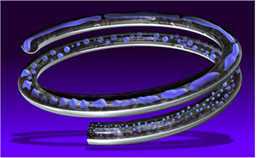
 Centrifugal Separation is the
most widely used method for separating fluids with different densities. It is
also used in separating solids from liquids or solids from gasses. To-date ,
commercially available separators utilizing centrifugal force for separation
fall in one of two categories,
Centrifugal Separation is the
most widely used method for separating fluids with different densities. It is
also used in separating solids from liquids or solids from gasses. To-date ,
commercially available separators utilizing centrifugal force for separation
fall in one of two categories,
Feed Properties |
|
|
|
Constant Flow+/-10% |
|
|
|
Fluctuating Flow |
|
|
|
Constant Oil Concentration |
|
|
|
Varying Oil Concentration |
|
|
|
Low Oil Concentration |
|
|
|
High Oil Concentration |
|
|
|
Oil Droplets <25 um |
|
|
|
Oil Droplets >25um |
|
|
|
Feed Properties |
|
|
|
Liquid in Gas |
|
|
|
Solid in Gas |
|
|
|
Oil in Water |
|
|
|
Water in Oil |
|
|
|
Solid in Liquid |
|
|
|